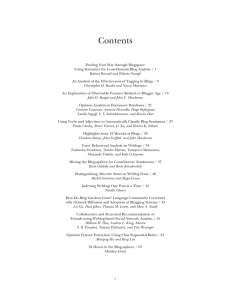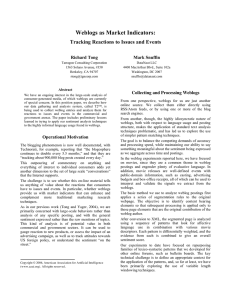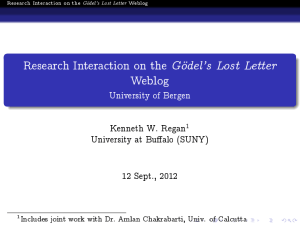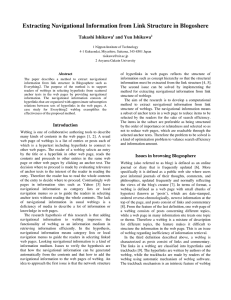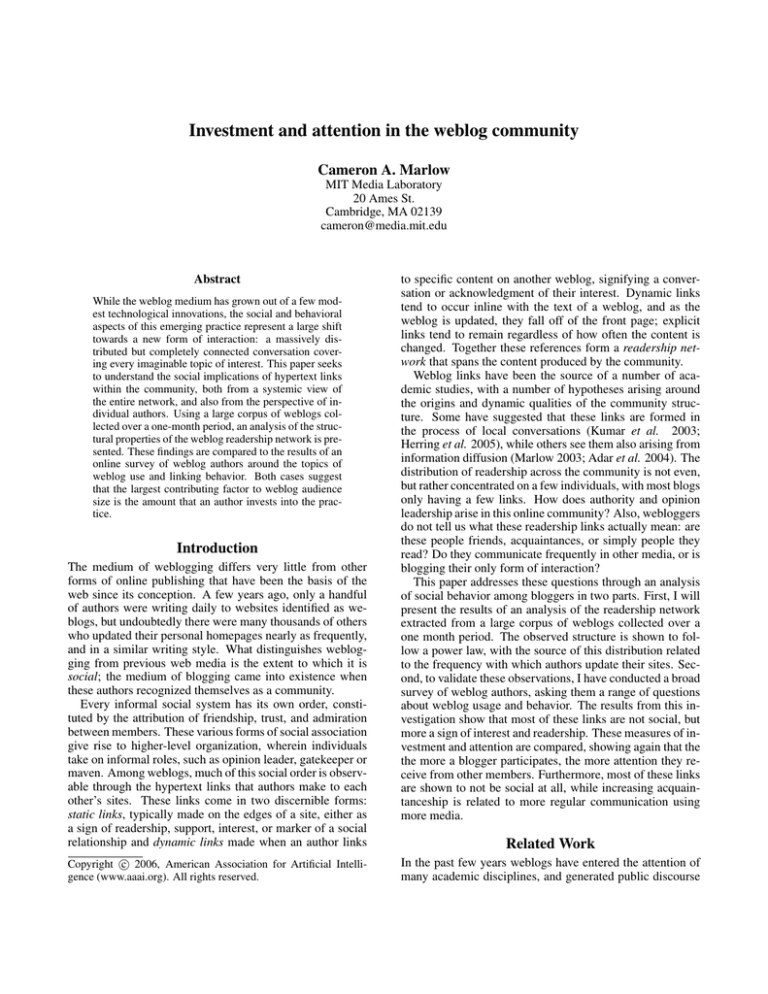
Investment and attention in the weblog community
Cameron A. Marlow
MIT Media Laboratory
20 Ames St.
Cambridge, MA 02139
cameron@media.mit.edu
Abstract
While the weblog medium has grown out of a few modest technological innovations, the social and behavioral
aspects of this emerging practice represent a large shift
towards a new form of interaction: a massively distributed but completely connected conversation covering every imaginable topic of interest. This paper seeks
to understand the social implications of hypertext links
within the community, both from a systemic view of
the entire network, and also from the perspective of individual authors. Using a large corpus of weblogs collected over a one-month period, an analysis of the structural properties of the weblog readership network is presented. These findings are compared to the results of an
online survey of weblog authors around the topics of
weblog use and linking behavior. Both cases suggest
that the largest contributing factor to weblog audience
size is the amount that an author invests into the practice.
Introduction
The medium of weblogging differs very little from other
forms of online publishing that have been the basis of the
web since its conception. A few years ago, only a handful
of authors were writing daily to websites identified as weblogs, but undoubtedly there were many thousands of others
who updated their personal homepages nearly as frequently,
and in a similar writing style. What distinguishes weblogging from previous web media is the extent to which it is
social; the medium of blogging came into existence when
these authors recognized themselves as a community.
Every informal social system has its own order, constituted by the attribution of friendship, trust, and admiration
between members. These various forms of social association
give rise to higher-level organization, wherein individuals
take on informal roles, such as opinion leader, gatekeeper or
maven. Among weblogs, much of this social order is observable through the hypertext links that authors make to each
other’s sites. These links come in two discernible forms:
static links, typically made on the edges of a site, either as
a sign of readership, support, interest, or marker of a social
relationship and dynamic links made when an author links
c 2006, American Association for Artificial IntelliCopyright gence (www.aaai.org). All rights reserved.
to specific content on another weblog, signifying a conversation or acknowledgment of their interest. Dynamic links
tend to occur inline with the text of a weblog, and as the
weblog is updated, they fall off of the front page; explicit
links tend to remain regardless of how often the content is
changed. Together these references form a readership network that spans the content produced by the community.
Weblog links have been the source of a number of academic studies, with a number of hypotheses arising around
the origins and dynamic qualities of the community structure. Some have suggested that these links are formed in
the process of local conversations (Kumar et al. 2003;
Herring et al. 2005), while others see them also arising from
information diffusion (Marlow 2003; Adar et al. 2004). The
distribution of readership across the community is not even,
but rather concentrated on a few individuals, with most blogs
only having a few links. How does authority and opinion
leadership arise in this online community? Also, webloggers
do not tell us what these readership links actually mean: are
these people friends, acquaintances, or simply people they
read? Do they communicate frequently in other media, or is
blogging their only form of interaction?
This paper addresses these questions through an analysis
of social behavior among bloggers in two parts. First, I will
present the results of an analysis of the readership network
extracted from a large corpus of weblogs collected over a
one month period. The observed structure is shown to follow a power law, with the source of this distribution related
to the frequency with which authors update their sites. Second, to validate these observations, I have conducted a broad
survey of weblog authors, asking them a range of questions
about weblog usage and behavior. The results from this investigation show that most of these links are not social, but
more a sign of interest and readership. These measures of investment and attention are compared, showing again that the
the more a blogger participates, the more attention they receive from other members. Furthermore, most of these links
are shown to not be social at all, while increasing acquaintanceship is related to more regular communication using
more media.
Related Work
In the past few years weblogs have entered the attention of
many academic disciplines, and generated public discourse
around the social and cultural impact of this community.
This research is too broad to be covered entirely here; instead I will present research dealing with models and analyses of link topologies and social structure. To understand
the significance of weblog ties in the larger context of online communities, I will first review some applicable work
in the areas of computer mediated communication (CMC)
and internet sociology.
Online communities
Early research on the social nature of the internet focused
heavily on social ties formed online. In his description of
the early online community known as “The Well,” Rheingold showed that people without prior contact were coming
together around mutual interests and personal interest, providing conversation, information, and social support (Rheingold 1994). As opposed to offline ties, these relationships
are often more specialized, revolving around one or a few
interests (Wellman & Gulia 1999). However, online relationships do not stay online forever; with continued social
interest, users tend to increase the multiplexity (the number
of simultaneous communication media) of their communication, and eventually meet face-to-face (Parks & Floyd 1996).
While much of the CMC research focuses on surveys or
ethnographic context, some methodological advancements
have been made in the computational analysis of online interaction. The work in this area has typically approached
data acquisition from perspective of the individual; using
pre-existing archives or by watching a person over time,
large sets of personal interactions can be culled, and structural analysis tools applied to the resulting ego-networks.
Since many people keep extensive email archives, these
have been a popular source of social data (Haythornthwaite
2000), with in- and out-links being determined by emails
received and sent to other individuals.
Smith provides a systemic analysis of a community, looking at the conversations occurring on Usenet over a few
months; in this research he has devised different measures
of social exchange, a user typography, and global characteristics of the entire system (Smith 1999). Similarly, a
number of projects have attempted to infer social relationships from links on the web at large (Adamic & Adar 2003;
Gibson, Kleinberg, & Raghavan 1998; Flake, Lawrence, &
Lee Giles 2000). While these data are much further removed
from explicit social interaction, they provide perspective on
the process of collecting data and allow us to start working
on the hurdles posed by the analysis of large data sets.
(Herring et al. 2005). Some studies extend this representation by inferring links from other features, such as link
similarity, content overlap, and timing of updates (Adar et
al. 2004; Gruhl et al. 2004).
Based on a subset of weblogs collected from weblog directories (such as the “weblogs” category on Yahoo!), Kumar and colleagues have looked at the whole-network properties of this community over a long period of time (Kumar
et al. 2003). They extracted a sample of roughly 20,000 weblogs and a historical archive to obtain a longitudinal sample. They observed a graph of about 70k edges with dense
subgraphs that revealed “bursty” linking behavior and embedded communities that were easily extracted.
Herring et al. (2005) have recently conducted a general
analytic survey of the structure of the weblog community using both quantitative and qualitative methods. Using a sample obtained from the Blo.gs ping service, four random weblogs were selected, and from those weblogs an ego-network
of alters identified. This set of 5,517 weblogs was manually identified and analyzed. They found a range of different types of social interaction, from one-directional affiliation to repeated, reciprocal referencing between authors,
concluding that the majority of weblogs are disconnected,
while some dense cliques exist in fewer areas. Their findings suggest that contrary to the bursty nature described by
(Kumar et al. 2003), few weblogs actually engage in regular,
reciprocal dialog.
A controversial essay published by Clay Shirky claims
that the distribution of popularity and attention was disproportionately skewed towards a few individuals (Shirky
2003). He observed that weblog links follow a power law,
and furthermore that this distribution was probably caused
by the generative process known as preferential attachment,
popularized by network researcher Albert-László Barabási.
In his model, Barabási suggests that many power law distributions arise from the more connected nodes collecting
more links, allowing for a feedback loop wherein the “rich
get richer” (Barabási 2002). This inherent inequality gave
rise to a heated debate as it suggests that popularity and authority are not caused by the quality or knowledge of the author, but rather by the amount of time they have been active
within the community.
Most of these studies have made the assumption that linking and topic similarity are in some way “social,” imply
“ties,” but none have presented a broad analysis of the true
meaning of these relations1 At this point we can refer to weblog interconnections as a “readership network,” but real social relations need to be empirically confirmed.
Weblog structure
The nature of weblog interaction is quite conducive to study
and has the potential to extend CMC research, since many
forms of weblog affiliation are made in an explicit manner in
a public forum. Bloggers’ hypertext links have been seen as
a network of readership and social relations in a number of
different research projects (Marlow 2003; Adar et al. 2004;
Herring et al. 2004; 2005). Typically these studies present
static links as a form of readership, with dynamic links
implying discourse or interaction around a particular topic
Design and Methodology
This section describes the methodology used in this paper.
The first section speaks at length to considerations around
the sampling of weblogs, followed by a description of data
acquisition, analysis and survey techniques.
1
Herring et al. (2005) have looked at this more closely, but their
sample consisted of a qualitative sample of 24 weblogs.
Sample
Since there is no global system for tracking the existence of
weblogs, there are a number of mitigating factors that help
decide which frame population to use. There are four tried
methods for acquiring weblogs: online directories where
authors self-categorize their weblogs into a catalog, open
spidering of the web using heuristics or statistical measures to identify blogs, large applications such as Blogger, Livejournal or Xanga where the population is specified, and finally ping servers where weblogs can identify
themselves when they are updated. While most industry
surveys have used applications (Perseus Development 2004;
2005), the most important features for this study are accuracy and recency. For this reason I have chosen to use ping
servers to acquire the sample, with the most obvious choice
being the popular public server, Blo.gs (Winstead 2005).
Aggregator
The first part of this study is an analysis of the link structures inherent in the content of weblogs. In order to produce
a data set for analysis, I must first collect a large corpus of
weblog content; this task will be executed by a crawling and
indexing system built for this study. This tool will continuously monitor updates to the ping server and collects data
about updated weblogs over time. The content of updated
weblogs will be fetched and stored, all of the external links
are extracted, and indexed in the event that they connote
readership (i.e. links made between weblogs). These links
are further distinguished as either dynamic, or referencing
specific, deep content on another blog, or static, pointing to
the to the front page2 .
Since the weblogs that are obtained from Blo.gs are not
constrained to America or even English-speaking authors,
any number of languages may be used in the writing of the
aggregated sites. While this should not affect the analysis, I needed to provide some facility for selecting English
blogs for use in the survey section of the study. A statistical language identification system described by has been implemented to characterize the sample I have obtained from
Blo.gs (Ceglowski 2005).
The aggregator was set to run for a one-month period for
data collection. The first stage of analysis involves a structural analysis of the readership network. Given the estimates
on the total number of weblogs, the expected network will
be on the order of millions of nodes, too large for many of
the measures employed by social networks research. Subsampling this network would remove the overall context,
and looking only at individual nodes would take forever, but
we can get a similar feel simply by looking at various calculable measures.
After the data set has been cleaned of all obvious abnormalities, the first step is to convert it into a form that
is amenable to most network measures which require connectivity. Two induced subgraphs, forming the largest connected component and the largest strongly connected components (Cormen 2001) must be calculated. Given previ2
Details for the construction of the crawling, indexing, and link
extraction can be found in (Marlow 2005).
ous analysis of blog readership networks (Marlow 2003;
Adar et al. 2004), the largest connected component should
account for a large percentage of the entire network.
Previous studies of weblogs have revealed power-law distributions for both in- and out-degree of the readership network (Marlow 2003; Kumar et al. 2003; Adar et al. 2004;
Gruhl et al. 2004), and a similar result is expected. There
are a number of features that scaling might be contingent
upon: frequency of posting, quality of posting, connections
outside the network, and any number of demographic variables. In this part of the analysis I have looked to see if there
is any relation between other variables I have observed.
Survey
The purpose of the weblog survey is to validate the observations made in the previous section, while adding context to the social implications of readership links. The survey will take advantage of two samples: a random sample
culled from email addresses extracted from the aggregated
weblogs, requiring 5,000 addresses to achieve representivity3 , and a self-selected sample including all of those subjects who found the survey through public channels. The
survey contains five sections in total, two of which are relevant to the topic of this paper: one on the meaning of links
made between authors and a section on their use of weblog
technology.
Weblog Use In the first relevant section, subjects were
asked to detail their experience with weblogs along with the
behaviors of their audience. To measure the level of commitment that a given subject had towards their site, the survey contained a number of questions about the time invested
into various related activities. Weblog acts were divided into
three different pursuits: number of other sites read, number
of posts per week, number of comments made on other weblogs, and a general question about the total time invested
during an average week. Against these variables I wished
to measure the effect that this input had on the popularity of
their site, as quantified by their self-reported audience size
and the comments received in an average week.
Links After subjects submit the address of their weblog,
the content is fetched at that time and links extracted, in the
same method used by the weblog aggregator. A set of 5
links are randomly selected. For each of these links, subjects
were asked to classify the link into a number of different social categories (weblog, weblog post, personal homepage)
or “other” for any other link. Subjects were then given subsequent questions about the link based on the type specified.
When authors specified that the link was made to another
person’s web page, the questions that followed were about
the relationship between the subject and the weblog they
linked to. The first question asks the type of relationship the
3
Given an expected target population of about 750,000 authors,
a confidence level of 95% and interval of 3%, and the 20-30% response that can be expected from online surveys (Bosnjak & Tuten
2003), these figures imply a sample of 5,330 subjects or a round
5,000 with a response rate of over 21.3%
author had with the alter: friend4 , family, acquaintance, or
“don’t know them personally.” The subject was then asked
questions about this alter and their weblog: when they had
last read the site, when they had last posted a comment on
it, and when (if ever) they had met the author in person.
Results
During the months of May and June 2005, the weblog aggregator observed the weblog community and collected data
on individual behaviors. During the second and third weeks
of June, the weblog survey was presented to both a random
sample of authors and also to anyone who wished to participate. This section will detail the results and analyses of
these two studies.
Aggregator
The aggregator started collecting data on May 16th, 2005.
Sometime during the month of May, Blo.gs was sold to Yahoo! Inc., unbeknownst to anyone in the weblog community, and despite my coordinated preparation with Yahoo!,
the service was still unavailable between June 14th and June
16th.
1800000
1600000
Weblog Updates
1400000
Links Observed
Count
1200000
Language Of the 1,034,498 weblogs identified, 386,942
weblogs had a language detected by the classifier. English
held a strong majority at 70.4% followed by Japanese with
9.9% and Spanish with 3.4%. The list includes some surprising activity in a few languages. Compared to internet market
research statistics of expected Internet populations (Global
Reach 2005), the largest anomalies among this list are Portuguese and Farsi, which are far above their projected values.
This data exposes some of the international biases existing
in the sample obtained from Blo.gs. First, in some countries
blogging is centralized around one or a few services, such as
Cyworld in Korea (Lee 2004). Since there is little need for
outside aggregation of this material, these services tend not
to involve themselves with ping tools. Second, some countries have their own ping services that do not interface with
Blo.gs. Such ping servers are popular in Japan and France
while others in Sweden, Brazil, Germany and Poland are
less active.
Data Refinement Because Blo.gs is an open system with
a published programmatic interface, it is susceptible to a
number of different types of specious activity. There are
many fraudulent uses of weblogs, most of which are aimed
at the individual weblogs of legitimate authors, white some
involve entire weblogs. Without checking every site individually, it will be impossible to completely remove spam from
this data set. However, because spam authors tend to use automated methods that create observable abnormalities, I first
needed to clean the data to diminish their impact as much as
possible through a number of steps of refinement.
1000000
1000000
800000
600000
100000
200000
0
13-May
20-May
27-May
3-Jun
10-Jun
17-Jun
24-Jun
Time
Weblog Count
400000
10000
1000
100
Figure 1: Weblog updates during the sample period
10
Over the course of the 37 day period, over 15 million links
were extracted from about 1 million weblogs. The updates
observed are presented in Figure 1, showing the drop-out of
the Blo.gs service towards the end of the data-collection period. When weblogs are indexed initially, all links contained
on the front page of the weblog are added to the database,
including many that existed before the current update. This
mass of relatively static links will be indexed the first time
a weblog is crawled, and afterwards a much smaller set of
new links will be found. This process of “getting to know”
a weblog explains the severe peak and drop-off that occurs
at the beginning of the data collection and shortly after the
dropout of Blo.gs.
4
We define friend in the same respect as social network researchers, or “someone you feel especially close to” (Marsden
1984).
1
1
10
100
1000
Out Degree
Figure 2: The initial observed cumulative out-degree distribution for the readership network.
The largest number of updates came from a weblog with
over 3,000 in 34 days, or just about 88 updates per day. This
amazing accomplishment suggests one of two explanations:
either these updates are automated, or there is more than one
person at work in changing the content of this weblog. The
first method for dealing with spam is to manually check the
top updated sites for fraudulent use. This technique does
not cover a broad range of spammers, but it removes a large
amount of inaccurate links in a short amount of time. I have
deleted these weblogs, which consumed a full 85 of the top
100 updaters.
My initial readership network contained around 425,000
weblogs with at least one out-link, and about 500,000 including those with one in-linksa well. Figure 2 shows the
initial out-degree of the readership network plotted on a loglog scale. There are a number of large spikes off of what
would otherwise be a power-law distribution, most notably
around the degrees of 7, 25, 31, 174, 195 and 218. Closer
inspection reveals the fact that these weblogs have been automatically generated, and are not weblogs at all, but farms
of spam blogs.
1000000
Weblog Count
100000
Out-degree
In-degree
10000
1000
these languages, without a spidering approach to weblog acquisition, or a global ping server, they will remain isolated.
Degree The degree distribution of our readership network
can be a measure of how popularity, attention, and influence
is divided up amongst our blog authors. Of the links collected over the sample period, 1,399,749 static readership
links were observed, and 541,234 dynamic, making the ratio
2.6:1. Given the short time frame of the study, I had expected
this ratio to be much higher, especially since, accounting for
aggregation over time, my last look at similar data suggested
something in the range of 10:1 (Marlow 2004). Pearson correlations between the static and dynamic in- and out-degrees
are shown in Table 1.
In-Static In-Dynamic
In-Dynamic 0.825
Out-Static 0.120
0.063
Out-Dynamic 0.077
0.066
p < 0.001 for all measures
Out-Static
0.259
100
Table 1: Correlations between in- and out-degrees for both
static and dynamic links
10
1
1
10
100
1000
10000
Degree
Figure 3: The initial observed cumulative degree distribution
for the readership network.
By removing these weblogs from the readership network,
we achieve the more believable distributions shown in Figure 3. However, the massive spike at the tail of the distribution is quite abnormal. Looking at the list of blogs with top
in-degree, the first 7 blogs have 3 times the number of inlinks as the next site, Slashdot, which is unmistakably one
of the more popular sites on the internet. Each of these rank
leaders is a weblog written by an author of the popular, opensource weblog software Wordpress (Wordpress 2005). Their
dominance in the readership network is not determined by
their popularity or influence, but rather because each new
installation of Wordpress comes pre-configured with links
to the authors. These links were removed from the data, excepting those that did not include the entire pre-configured
set.
Connectedness To arrive at the components in a digraph,
the graph is first converted to its undirected form and
then searched using breadth-first-search (Cormen 2001, p.
532). Starting with an initial network of 385,350 nodes and
1,970,402 edges, the largest connected component contains
343,743 nodes. Almost 90% of the weblogs updated over
the sample period are in one component, a striking observation that shows the social nature of blog authorship. A qualitative inspection of the other large components (N > 10)
reveals networks of spam, with smaller components showing
blogs in foreign languages, suggesting a pocket of authors in
another country who use tools that ping Blo.gs. While a path
probably exists from our main component to other authors in
Despite the fact that degree in these networks has an extremely high variance, we do see some relationship between
the two, and in the case of In-degree, the relationship is quite
strong. This implies that for variations around the mean of
the distribution (which will be a low in-degree), the relationship will be so strong it will overcome the exceptionally
large variance.
Investment What property exactly is it that determines
popularity, either from a dynamic or static perspective? My
first assumption would be the quality of the information provided, and its general applicability to a wide range of interests. But one of the surprising characteristics of these top
sites is the sheer volume of information that they produce.
The top three sites across both lists Slashdot, BoingBoing
and Engadget had 396, 791 and 615 updates respectively
over the sample period. For BoingBoing and Engadget that
amounts to over 20 posts per day, and each from only a small
number of writers.
Figure 4 shows the relationship between the number of
updates made over the course of the aggregation and indegree from dynamic links. The average number of updates over this period is shown in a cumulative fashion; for
each in-degree, the value represents the average number of
posts above that degree. Without any gauge of quality, it
is clear that there is a strong relationship between the frequency of posting and a weblog’s in-degree, and more-so
for dynamic links than static. Intuitively this contradicts the
notion that these power laws exist because of preferential attachment; if your degree purely related to the time at which
you joined the network, then why is there such a clear relationship to the amount of information provided by these top
sites? The fact that recent weblogs such as Engadget and
Gizmodo can have such dominance also throws a wrench
into the Barabási/Shirky argument. These data would suggest that there is more than just one force determining the
10000
Sample
Random
Dynamic in-degree
1000
Self-selected
100
LiveJournal
10
Total
1
0.1
1
10
100
1000
10000
# of updates
Figure 4: Updates vs. Dynamic in-degree
growth of these networks.
Survey
The general survey was released in two phases, first as an
email to the random-sample subjects, and then publicized
on a number of popular weblogs. The growth of the survey starting growing exponentially in the self-select sample in the second week after some promotional buttons were
added, allowing bloggers to help advertise the survey.
A few caveats should be made explicit. First, the survey did not fully address issues of multiple authors. Second, it was not available in any language other than English, despite the fact that many of the respondents live in
non-english speaking countries. Finally, I did not expect
the response that I received from the LiveJournal community, which accounted for about 50% of the subjects in the
self-selected sample. Because the security and structure of
a LiveJournal blogs is considerably different than others,
it is important that we represent them as a separate sample. This partitioning gives three total sample populations:
random, those emailed directly to participate, and two selfselected groups that found the survey through other means,
LiveJournal, those identified as being from LiveJournal, and
self-selected, the remaining subjects.
In the random sample, 5003 subjects were emailed at
the beginning of the suvery period. Of these initial emails,
1,369 completed the survey with 3,125 not responding at all.
These figures translate into a 29% response rate, very close
to those obtained in other emailed random-sample surveys
(Bosnjak & Tuten 2003), a respectable response given the
high probability for error in the extracted emails..
Table 2 contains the general demographic information
(age, sex and education) for all three samples. Age was
measured as the current year (2005) minus the year they entered as their birth year, sex was coded as 0 for male and
1 for female, and education was coded as 0 being less than
High School to 6 being a graduate degree. Compared to
previous broad weblog surveys (Perseus Development 2004;
2005), the most striking difference in the demographics is
the male-dominated random-sample population. A number
µ
σ
N
µ
σ
N
µ
σ
N
µ
σ
N
Age
30.2
10.6
1,358
29.2
9.3
12,774
26.7
7.5
15,776
27.8
8.7
35,254
Sex
.31
.46
1,360
.55
.50
12,732
.71
.45
15,736
.62
.48
35,195
Education
2.6
1.1
1,361
2.6
1.1
12,787
2.4
.9
15,817
2.5
1.0
35,327
Table 2: Sample demographics. Sex is coded as 0/1 for
male/female and education as 0 for “less than High School”
with 6 as a graduate degree.
of reasons might explain this bias, but the most likely is that
men might be more willing to put their email addresses on
the front page of their weblog. Comparing the LiveJournal statistics to those provided by the service (LiveJournal
2005), the samples are extremely similar, with the exception of survey respondents being slightly older ( 4 years) and
slightly more educated.
Weblog use The first section addressed the various ways
in which authors utilized their weblogs, and types of activities they engaged in on other sites. Table 3 shows the correlations between each of these activities for all of the samples. Nearly every investment is positively correlated with
the others, suggesting that as the amount of time spent increased, so did each of these various activities. Most notable is the relationship between commenting, posting, and
receiving comments. Likewise, the relationship between audience size, albeit self-reported, varies according to these investment measures, as does the authors expectation of how
long they will continue the activity.
Self-selected LiveJournal
Size
Cin Size Cin
Read .220
.352 .342 .542
Time .271
.308 .331 .327
Cout .475
.331 .436 .492
Post
.501
.322 .666 .280
p < 0.001 for all values
Random
Size Cin
.260 .296
.319 .313
.459 .266
.424 .324
Table 3: Correlations between investment and audience. Investment into weblogging: Read is the number of weblogs an author reads weekly; Time is total
time invested weekly, Cout is the frequency of comments made by the author, Post is their post frequency,
Cin is the frequency of comments received, and Size is
self-reported audience size.
Taking the sum of each investment measure we can each
of these ordinal measures, I have constructed an aggregate
value of investment. Figure 5 shows the relationship between this value and the self-reported audience size as a
scatterplot histogram. This plot complements the observations made from the aggregator data, showing a clear relationship between investment and audience size. Unfortunately, without longitudinal data, I cannot definitively determine the direction of the causality; it might be the case
that the more popular weblogs inspire their authors to invest more time, or the invested time could be rewarded with
larger audiences and more frequent comments. The relationship between comments posted and comments received
though, regardless of its origin, suggests that commenting is
not an activity that can be maintained without some investment back into the community.
Scale
1,400
Audience Size
800
Relationship
No Relation
Acquaintance
Friend
Family
Post (%)
69.1
12.7
13.8
4.4
Table 4: Social link type and relationship
types and the reported relationship between the subject and
the other author. As would be expected, dynamic links do
not necessarily imply any sort of personal interaction and
static links are associated with higher levels of acquaintance
than dynamic. However, the number of ties identified as
having no social basis is remarkably high; over 50% were
made to weblogs written by individuals with whom the subject does not even consider an acquaintance.
0
Last read
Never
Over a year ago
6 Mo. - 1 Year
1 Mo. - 6 Mo.
1 Week - 1 Mo.
This Week
Today
Total
Investment
Figure 5: Relationship between author investment and selfreported audience size.
Links In the links section of the survey, subjects were
asked to answer questions about links that were extracted
from their weblog. Because of security problems involved
in accessing LiveJournal sites, very few LiveJournal subjects succeeded in answering these questions. For this reason I will only consider those subjects in the random and
self-selected samples for this section.
Of the 26,075 links listed as social links, exactly 9,700
came from a disregarded sample (LiveJournal or incomplete), and an addition 1,351 were missing data for all of the
subsequent questions. After excluding these links, the data
includes 15,024 samples of links listed as weblog, weblog
post, or personal homepage, with 10,275 (68.3%), 2,632
(17.5%), and 1,637 (10.9%) links respectively.
Removing the personal homepages, the ratio of static to
dynamic social links is about 4:1, which is smaller than
the rate observed by the aggregator, 2.6:1. This discrepancy probably stems from two issues: first, the number of
dynamic links observed on all weblogs over the course of
a month will aggregate to a larger number than would be
found at any given day on the front pages of the same sites.
Second, in cases where the subject does not know the author
of a given weblog post, they might not see it as such.
Table 4 shows the associations between the various link
Link Type
Weblog (%) Homepage (%)
55.1
43.4
18.2
17.0
23.6
30.1
3.1
9.5
Alter’s relation to the author
None
Acq. Friend Family
4.5
0.9
0.7
0.8
0.8
0.9
0.7
0.2
2.0
1.8
1.2
1.7
8.8
7.4
6.1
3.1
21.5
19.4
14.0
15.2
32.7
33.8
31.6
23.6
29.7
35.8
45.8
55.4
100 % 100 % 100 %
100 %
Table 5: Readership and relationship
The next addressed is how many of these links are “live,”
denoting weblogs that the subject reads regularly and how
many are “dead,” pointing to readership that no longer exists. Table 5 shows the distribution of readership as described by the last time the author read the given weblog for
each type of relation to the author. While I expected to find
high readership for friends’ weblogs, I was surprised to see
that for all levels of acquaintanceship over 80% of the identified weblogs had been visited in the last month, and over
60% in the last week. As would be expected, the stronger the
social tie described by this link, the more likely the subject
is to read them regularly. Over 50% of the familial weblogs
were read the day the survey was taken, and nearly 50% for
those denoted as friends.
There is probably be some amount of bias associated with
affirmation of the subjects self-image, namely that misremember their reading as much more frequent than in reality. they would rather remember having read these weblogs
more recently than they may actually have. The division of
time periods was explicitly chosen to minimize the generalized bias shown by the pilot subjects, but it has the downside
of including large ranges of time.
Along with the observations made in the weblog use section, these data reinforce the idea that there are a number of
types of interaction being expressed in the form described as
a weblog. While some of the more specialized, professional
weblogs can be non-social, blogging is at its core a social
tool, capable of reinforcing friendships as well as allowing
for new connections.
Conclusions and Future Work
The data collected by the aggregator provided a rich network
of relationships that could be used to understand the possible
social structure within the community. The extracted network consisted of over 300,000 nodes and 1.7 million edges;
the distribution of these edges as represented by in-degree
followed a power law, suggesting that a large percentage of
the attention within the community was governed by a few
select weblogs. Both of the observed networks were almost
entirely connected, having only a few components besides
the largest one.
Probably the most important contribution to understanding this community was the observation of a strong relationship between investment in the weblog and payoff in terms
of audience size and feedback. As I anticipated, these measures of investment were shown to correlate very strongly
with measures of attention and audience size. These data
show that the weblog community rewards the author who
puts time into their work, and that the length of one’s blogging history does not solely determine their future audience.
In this case, it is the hard-workers who get richer, not the
previously-rich.
In order to make stronger claims about these results, a longitudinal studies replicating the aggregator and survey are in
order. This would allow us to evaluate the causality of a
number of the observations made here.
References
Adamic, L., and Adar, E. 2003. Friends and neighbors on the
web. Social Networks 25(3):211–230.
Adar, E.; Adamic, L.; Zhang, L.; and Lukose, R. M. 2004. Implicit structure and the dynamics of blogspace. In Workshop on
the Weblogging Ecosystem at the 13th International World Wide
Web Conference.
Barabási, A.-L. 2002. Linked : the new science of networks.
Cambridge, Mass.: Perseus Pub.
Bosnjak, M., and Tuten, T. 2003. Prepaid and promised incentives
in web surveys: An experiment. Social Science Computer Review
21(2):208–217.
Ceglowski, M. Languid: A language identification system [online]. 2005 [cited July 12, 2005]. Available from: http:
//languid.cantbedone.org.
Cormen, L. C. E. R. R. R. S. C. 2001. Introduction to algorithms.
MIT Press, 2nd edition edition.
Flake, G.; Lawrence, S.; and Lee Giles, C. 2000. Efficient identification of web communitites. In Proceedings of the 6th ACM
Conference on Knowledge Discovery and Data Mining, 150–160.
Gibson, D.; Kleinberg, J. M.; and Raghavan, P. 1998. Inferring
web communities from link topology. In Proceedings of the 9th
ACM Conference on Hypertext and Hypermedia.
Global Reach. 2005. Global internet statistics (by language).
Technical report, Global Reach. Available from: http://www.
glreach.com/globstats/ [cited June 26, 2005].
Gruhl, D.; Liben-Nowell, D.; Guha, R.; and Tomkins, A. 2004.
Information diffusion through blogspace. In Proceedings of the
ACM Conference on the World Wide Web.
Haythornthwaite, C. 2000. Online personal networks: Size, composition and media use among distance learners. New Media
&amp; Society 2(2):195–226.
Herring, S. C.; Scheidt, L. A.; Bonus, S.; and Wright, E. 2004.
Bridging the gap: A genre analysis of weblogs. In Proceedings
of the 37th Hawaii International Conference on System Sciences
(HICSS’04). Los Alamitos: IEEE Press.
Herring, S. C.; Kouper, I.; Paolillo, J. C.; Scheidt, L. A.; Tyworth,
M.; and Welsch, P. 2005. Conversations in the blogosphere: An
analysis ”from the bottom-up”. In Proceedings of the 38th Hawaii
International Conference on System Sciences (HICSS’05). Los
Almitos: IEEE Press.
Kumar, R.; Raghavan, P.; Novak, J.; and Tomkins, A. 2003. On
the bursty evolution of blogspace. In Proceedings of the ACM
Conference on the World Wide Web.
Lee, S. H.
Souped-up blog takes south korea by
storm [online].
December 2004.
Available from:
http://www.iht.com/articles/2004/12/30/
business/ptkorblog.html.
LiveJournal. Livejournal.com statistics [online]. 2005 [cited
July 2, 2005]. Available from: http://www.livejournal.
com/stats.bml.
Marlow, C. 2003. Modeling emergent communitites through
diffusion. In Sunbelt International Social Networks Conference
XXIII.
Marlow, C. 2004. Audience, structure and authority in the weblog community. In 54th Annual Conference of the International
Communications Association.
Marlow, C. 2005. The stuctural determinants of media contagion.
Ph.D. Dissertation, Massachusetts Institute of Technology.
Marsden, P. 1984. Measuring tie strength. Social Forces 63:482–
501.
Parks, M. R., and Floyd, K. 1996. Making friends in cyberspace.
Journal of Communications 46(1):80–97.
Perseus Development. 2004. The blogging iceberg: Of 4.12
million hosted weblogs, most little seen and quickly abandoned.
Technical report, Perseus Development.
Perseus Development. 2005. The blogging geyser: 31.6 million
hosted blogs, growing to 53.4 million by year end. Technical
report, Perseus Development.
Rheingold, H. 1994. The Virtual Community: Homesteading on
the Electronic Frontier. The MIT Press.
Shirky, C. Power laws, weblogs, and inequality [online]. February
2003. Available from: http://shirky.com/writings/
powerlaw weblog.html.
Smith, M. 1999. Communities in cyberspace. Routledge. chapter
Inivisible crowds in cyberspace: Mapping the social structure of
the Usenet.
Wellman, B., and Gulia, M. 1999. Networks in the global village.
Boulder, CO: Westview. chapter Net surfers don’t ride alone:
Virtual communities as communitites.
Winstead, J. Blo.gs [online]. 2005. Available from: http:
//blo.gs/.
Wordpress. Wordpress weblog software [online]. 2005 [cited
June 25, 2005]. Available from: http://www.wordpress.
org.


